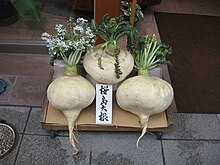Sakurajima radish
| Sakurajima radish | |
|---|---|

| |
| A pile of Sakurajima radishes. | |
| Scientific classification | |
| Kingdom: | |
| (unranked): | |
| (unranked): | |
| (unranked): | |
| Order: | |
| Family: | |
| Genus: | |
| Species: | |
| Variety: | R. sativus var. longipinnatus
|
| Trinomial name | |
| Raphanus sativus var. longipinnatus[1] | |
Sakurajima radishes or daikon (Template:Lang-jp, Sakurajima daikon) is a special cultivar of the Japanese radish named for its original place of cultivation, Sakurajima in Japan's Kagoshima Prefecture. It is the biggest radish variety in the world.[2] Its regular weight is about 6 kilograms (13 lb), although big ones can be as much as 45 kg (99 lb). It grows as large as 50 cm (20 in) in diameter.[3] It is also sometimes known in Japanese as shimadekon ("island daikon").
There are three kinds of varieties—early, middle and late,—but most are the last.[4] The seeding period is from last August to first September and the harvest season is from December to February. To reach full size, special care needs to be taken with the region's volcanic-ash soil.
Uses
Sakurajima radish has a fine texture and is low in fiber. It is sweeter than the other daikon varieties. The typical cooking style is simmering such as furofuki daikon.[5] Also as preserved foods, kiriboshi daikon and tsukemono are famous. The big size of tsukemono, senmaizuke is sold in souvenir shops in Kagoshima.
History
There are three theories about its development:
- An origin from an original wild daikon in Sakurajima.
- An origin from hōryō daikon in Aichi Prefecture.
- An origin from kokubu daikon (hamanoichi daikon).
An 1804 mention of Kagoshima in reference to the giant Sakurajima radish shows it was cultured before then at least. The main production was north-west of Sakurajima but it was moved to the north later. About 1200 farm houses had about 200 hectares (490 acres) of growing area in sum total in the high season. Sakurajima radish is one of the most precious local commercial crops. Also, in every harvest season, the market called toikae (means exchange in Kagoshima dialect) was held in Kajiki (now part of Aira District) and people traded Sakurajima radishes with straw. However, the main crop was shifted to satsuma (mikan) from Sakurajima radishes, because the area of Sakurajima suffered so much damage from a 1914 eruption of the nearby volcano, decreasing the growing area to about 30 hectares (74 acres) by 1955. Furthermore, its growing area was decreased to about 1.5 hectares (3.7 acres) owing to ashfall between then and 2001.
The main growing districts of now are the suburbs of Kagoshima city and Kirishima city. Because of fewer eruptions recently, the growing area has been extended.
References
- ^ "Sorting Raphanus names". MULTILINGUAL MULTISCRIPT PLANT NAME DATABASE.
- ^ Guinness World Records.[citation needed]
- ^ The New official guide: Japan. Japan National Tourist Organization. 1975. p. 837. ISSN 0077-8591.
- ^ Useful Plants of Japan - Described and Illustrated. READ BOOKS. 2008. p. 20. ISBN 1-4086-3952-1.
- ^ "Furofukidaikon (ふろふき大根)" (in Japanese). Kikkoman.
- 今村知子 『かごしま文庫51 鹿児島の料理』 春苑堂出版、1999年、ISBN 4-915093-58-1 Template:Ja icon
- 串間俊文 『かごしま文庫26 鹿児島の園芸植物』 春苑堂出版、1995年、ISBN 4-915093-33-6 Template:Ja icon
- 橋村健一 『かごしま文庫13 桜島大噴火』 春苑堂出版、1994年、ISBN 4-915093-19-0 Template:Ja icon
